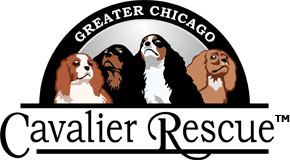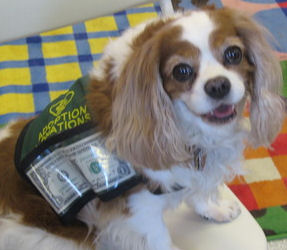-
Add cavaliers@gccavalierrescue.org to your contact list!
-
"Until one has loved an animal, part of his soul remains unawakened."....
-
"Every volunteer does a little bit to help needy Cavaliers; together we do a lot."....
-
"Heaven help the little Cavaliers who call for help, and no one comes.".....
Therapy Dogs Part 1 - The Power of a Wagging Tail
Many of us have a deep and complex relationship with our dogs – and they can have a tremendous impact on our lives. For most of us, they are truly cherished members of our family, but medical studies also support that owning a dog(s) can be very beneficial to our health.
On a basic level, we recognize our dogs often seem to be completely in tune with our moods and our daily habits, making it easy for them to provide stress relief or cheer us up. On a more serious level, they can help us better cope with chronic illnesses, achieve better outcomes with therapy, improve our social functioning, and even lower our blood pressure! Our pups can be “pawsitively” healing!
According to Dr. Edward Creagan, an oncologist at the Mayo Clinic in Rochester, MN, “Pets are embedded in the soul of our humanity”. What better way to describe the love and affection we all have for all of our pets – but especially the love we have for our beautiful Cavaliers?
So, what’s the best way to share some of this love? Have you ever considered training your Cavalier to become a therapy dog? First, let’s answer the question – what exactly is a therapy dog?
The concept of the therapy dog is an easy one. They provide comfort, affection, and companionship to people faced with difficult circumstances under many different scenarios.
According to Science Daily, the formal use of a therapy dog is first attributed to an American nurse named Elaine Smith. During the 1970s, Elaine worked in England with a Chaplain and his dog that he took on all his hospital visits. This dog made everyone smile and his effect on everyone was undeniable, but the pup was especially loved by the very young and elderly patients.
When Elaine returned to the U.S. in 1976, she started a program to train and bring dogs as “therapeutic ambassadors” into several nursing homes in the New Jersey area. Her work ultimately became the foundation for Therapy Dogs International (or “TDI”), the oldest registry for therapy dogs in the U.S.
More than 40 years later, therapy dogs are now an essential part of life for thousands of people, and there are many other formal training and registry programs for therapy dogs in the U.S. in addition to TDI.
So, we all know our Cavaliers make wonderful companions for us, but they can also make excellent therapy dogs! GCCR can count many therapy Cavaliers amongst our numbers who, along with their owners, are accomplishing wonderful things and spreading lots of love and compassion out in our communities.
Can your Cavalier be a good therapy dog? Let’s review the checklist and see….
- Is your Cavalier relatively calm around new people and new situations?
- Is your Cavalier patient and obedient? (OK, one or the other is pretty good)
- Is your Cavalier a barker? Quiet and a bit “less energetic” are generally best.
- Does your Cavalier like to be lifted up/down, touched, petted, and snuggled?
- Has your Cavalier passed (or can they pass) the AKC Canine Good Citizen test (CGC)?
- Do you have the time to commit to periodic visits with your Cavalier to various locations?
If you answered “Yes” to most of these questions, you and your Cavalier may be a perfect therapy team!
Keep in mind that a therapy dog can offer support, comfort and companionship in many different settings – not just in the usual nursing home or hospital settings. Consider some of the following ideas if the more traditional settings are uncomfortable for you or if you want to try something new…..
How about sharing your Cavalier(s) with local college students who are away from home for the first time and feeling homesick? Some colleges have similar programs around final exam time. Check with the college counseling and guidance office for more information.
Check with your local library to see if they sponsor a “Reading with Rover” program (community based literacy program) where you and your Cavalier can help children learn to read.
Can you bring your Cavalier(s) to work? Many large companies now offer this benefit, or allow therapy dog visits several times throughout the year. Check with your HR department to see if this is possible – or you might even start a program of your own at work!
You and your Cavalier may be able to help in a hospital setting without making traditional patient visits. Some hospitals have started to use therapy dogs to calm patients who were waiting for testing procedures. In fact, in 2011 a major Los Angeles hospital conducted an experiment by having a therapy dog spend 15 minutes with patients who were waiting for an enclosed MRI test – often an anxiety producing experience. Of the 34 total patients who participated, 28 spent time with the therapy dog and did not require any additional sedation at the time of their test. All 6 patients who did not spend time with the therapy dog required meds. Pretty amazing!
As you can see, the opportunities for therapy dogs can be unlimited. It just takes time and some effort on your part to arrange the time, training and transportation. If you think you and your dog have what it takes to reap the rewards of bringing fun and joy to others, check it out at the following links:
http://www.tdi-dog.org/HowToJoin.aspx?Page=Testing+Requirements
https://www.akc.org/akctherapydog/organizations.cfm (for an alphabetical list of therapy dog organizations nationwide)
February 2015








